
./20170819-1303-cet-7-2.png
- "Code without tests is broken by design.", Jacob Kaplan - Moss one of Django original developers.
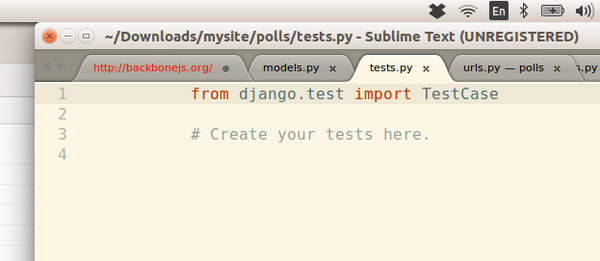
./20170819-1303-cet-7-5.png
from django.test import TestCase is used to import the Django unit test component into the codes.- Everything that inherited from
TestCase will be unit tested when the specific application is unit tested.
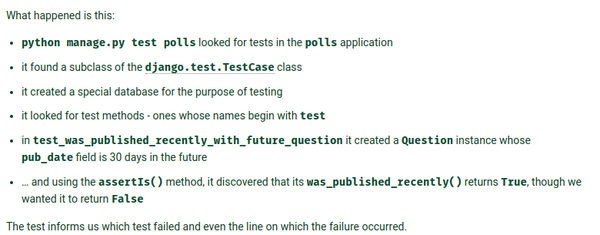
./20170819-1303-cet-7-8.png
- What happened during Django specific unit test.
- The command to launch Django unit test is from the manage.py,
python3 manage.py test application_name.
- When the unit test is ran it looks through any classes that inherited from
django.test.TestCase.
- The Django version of unit test goes with making its own exclusive database just for unit testing.
- For the function, it looks for every methods and functions that begin with name
test....
- There are a lot of assertion method that can be used to unit test the Django application.
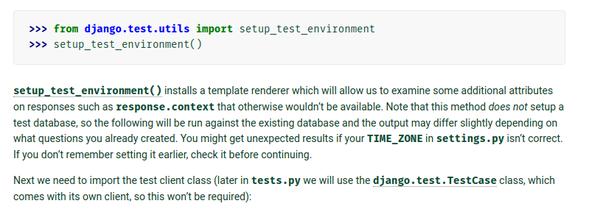
./20170819-1303-cet-7-11.png
- There is this method
setup_test_environment() from the from django.test.utils import setup_test_environment to automatically set a template render to help developer to unit test the view.
- By setting
setup_test_environment() the response.context become available to test and play around the server - client data transfer.
- However,
setup_test_environment() does not setup a test database.
- I am not sure if a database operation is included in the test with
setup_test_environment whether the operation will be failed of the test is included in the default/used database.
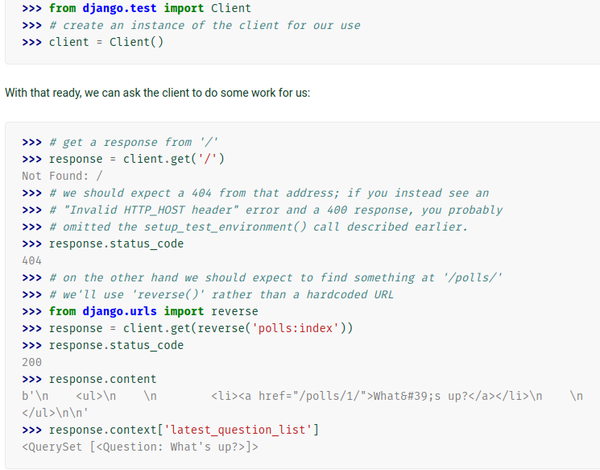
./20170819-1303-cet-7-14.png
>>> from django.test import Client
>>> # Create instance of client to simulate the front - end website headlessly.
>>> client = Client()
- And then use this codes to emulate a client visit one of the web page.
>>> # The emulated client visits index page.
>>> response = client.get("/")
- Then, you can get response code with these codes (for example because the index page of the project is not made yet, accessing index page will return on 404 error).
>>> response.status_code
404
- You can have the
client get into other view with hard written the URL or using the reverse() function to look after the URL from the urls.py (the table of contents of the Django application).
>>> from django.urls import reverse
>>> response = client.get(reverse("polls:index"))
>>> response.status_code
200
- Status code 200 is used if the web page loaded perfectly fine.
- These codes are used to view the HTML code from the client's loaded page.
>>> response.content
>>> # `response.content` will return the HTML as a raw file.
- In other case, if you want to see what is the data received from the server, you can use these codes.
>>> response.context
>>> response.context["latest_question_list"]
- The
"latest_question_list" is there from the client request to server when accessing the index page of the polls application.
- The request is for the server to give 5 latest available questions.

./20170819-1303-cet-7-17.png
- The timezone is matter for every case where real - world time is involved.
- Hence, please do not forget to set the
TIME_ZONE in the settings.py.

./20170819-1303-cet-7-20.png

./20170819-1303-cet-7-23.png

./20170819-1303-cet-7-26.png

./20170819-1303-cet-7-29.png
- The
__lte is means for a conditional operator less than and equal.
- Be careful here because the "l" in
__lte is "less". I thought the "l" was the abbreviation of "larger".

./20170819-1303-cet-7-32.png
- The query
Question.objects.filter(pub_date__lte=timezone.now()) will return a query set containing every questions that is stored in the database whose pub_date is less than or equal/earlier than or equal to timezone.now().

./20170819-1303-cet-7-35.png
return Question.objects.create(...)
- Is different with these codes.
return Question(pub_date=put_a_date_here, question_text="sample question?")
- The 1st codes means that we create and write a new
Question object into the database.
- The latter one means that we only create the
Question object but it is not written into the database yet.
- Further codes
question_object.save() will save the object question_object into the corresponding database.

./20170819-1303-cet-7-38.png
- The
self.assertContains(response, "No polls are available.") in Django unit test means to look for a specific string in the HTML view.
- Hence in order for this test to return
True in the rendered HTML in the web browser there should be No polls are available. listed there precisely.
- I was wondering why I was not able to pass this test, until I realize that the HTML view is different between the one in the tutorial and the one I wrote.
- Additionally to assert content at specific container (
<div>) Django's unit testing module is not yet capable to do so. Hence, based on the StackOverflow discussion here, https://stackoverflow.com/questions/2849457/django-unit-testing-html-tags-from-response-and-sessions. The solution is to use Python web scrapping framework like BeautifulSoup.
- Here is the screenshot of the StackOverflow discussion.

./20170819-1303-cet-7-41.png

./20170819-1303-cet-7-44.png
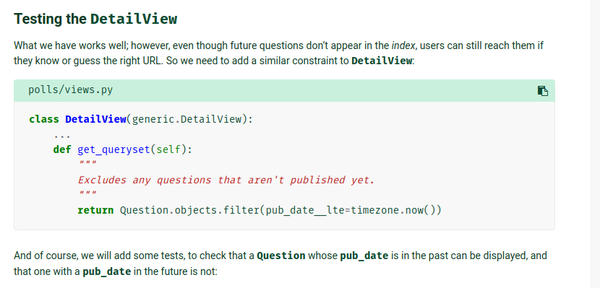
./20170819-1303-cet-7-47.png
- Example of unit testing the view of the
DetailView for the detail page when a user clicked at one of the question.
- The tutorial makes a bug when it supposed to list 5 newest questions, but the system also list questions from the future.

./20170819-1303-cet-7-50.png
- Every codes in the program needs to be accompanied with a test.
- At some point the bigger the program will be the project will suffer from test bloat.

./20170819-1303-cet-7-53.png
- When making codes the less the better.
- This process follows the Keep It Simple, Stupid (KISS) philosophy.
- But when making a unit test, it always better to keep as many as tests possible.
- The more test, the better it is.
- In test, having redundancy is no problem.

./20170819-1303-cet-7-56.png
- Let the unit tests grow!
- Make the test once and then forget it.
- Every tests made will still performing its usefulness throughout the development.

./20170819-1303-cet-7-59.png
- Unit tests will only need to be amended/refactored when the test fail or the previous conditions does not fit with the current goals.

./20170819-1303-cet-7-62.png
- In testing redundancy is a good thing.

./20170819-1303-cet-7-65.png

./20170819-1303-cet-7-68.png

./20170819-1303-cet-7-71.png
- Rules of thumb when designing/refactoring unit tests.
- Separate the class and document/file between the test file and the non - test file.
- Separate each test methods for each conditions you want to test. Last time I made a unit test I put it for 1 unit test function for a function I want to test. It should not be like that, per - case per function in unit test.
- Explicitly descriptive function name. Additionally, function name needs to start with
test_...

./20170819-1303-cet-7-74.png
- There is no test framework provided within Django to unit test how the view is rendered.
- There is a mature open source project for that, Selenium.
- Selenium can be ran headlessly and then perform unit test on how the views rendered in the web browser.

./20170819-1303-cet-7-77.png
- There is Continuous Integration test that will perform for every commit you made into the repository.

./20170819-1303-cet-7-80.png

./20170819-1303-cet-7-83.png
- The concept is that you always need to have a unit test for every codes in the application/program.
- However, the larger the program it is harder to know which codes have not yet tested.
- The manage.py in Django has
coverage command to check which part of codes are not yet unit tested.
- The
coverage command is not covered in this tutorial, but Django has a documentation about it.
- Here is the link to the tutorial, https://docs.djangoproject.com/en/1.11/intro/tutorial05/.
- Here is the screenshot of the tutorial.

./20170819-1303-cet-7-86.png




























